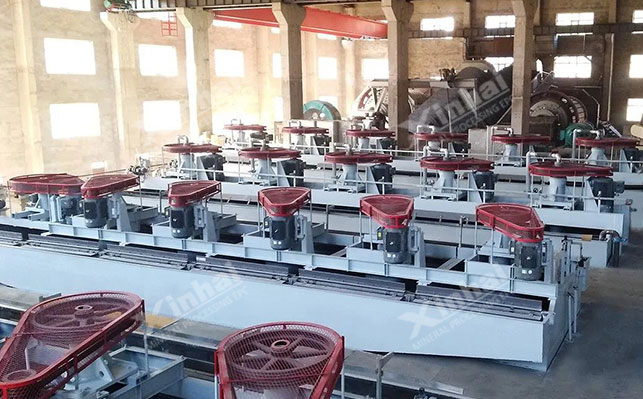The beneficiation process of copper lead zinc ore usually includes several key steps, with the aim of separating valuable metals from the original ore and maximizing the metal recovery rate. The beneficiation process may include the following stages:
The raw ore is preliminarily crushed by a crusher, breaking large pieces of ore into small pieces for subsequent processing.
After crushing, the raw ore needs to be finely ground, and the selection of grinding fineness is crucial as it affects the recovery rate of metals and the beneficiation effect. By adjusting the grinding fineness, the degree of individual metal dissociation can be optimized.
The slurry after grinding will enter the flotation process. Flotation is a commonly used mineral processing method that distinguishes the surface properties of different minerals by adding different reagents, allowing them to adhere to bubbles and be separated.
Possible flotation reagents to be used:
(1) Copper lead mixed flotation: using reagents such as lime, zinc sulfate, ethyl xanthate, and black medicine to distinguish between copper and lead.
(2) Lead zinc separation: After copper lead mixed flotation, specific reagents such as butyl xanthate are further used for lead zinc separation.
(3) Zinc tailings floating sulfur: Finally, sulfur recovery is carried out on the zinc tailings.

Mineral processing test process:
(1) Conditional testing: Before the formal large-scale beneficiation, a series of conditional tests will be conducted to determine the optimal reagent conditions and process parameters. This includes the use of inhibitors to prevent certain minerals from floating prematurely and to ensure smooth transitions between processes.
(2) Closed circuit test: This is a process that simulates the entire beneficiation process to verify whether the selected process parameters can produce ideal concentrate quality and recovery rate. For this ore, closed circuit tests have shown that satisfactory copper, lead, and zinc concentrates can be obtained through the methods of 2 fine and 1 sweep for copper, 4 fine and 1 sweep for lead, and 2 fine and 1 sweep for zinc.
Throughout the process, due to the symbiotic nature of the ore, the addition of inhibitors is necessary to avoid the formation of difficult to separate mixed minerals. In addition, other factors such as leaching time and grinding fineness will also be considered, which can affect the removal rate of impurities and the loss rate of metals. For example, acid leaching tests have shown that under appropriate conditions, the removal rate of impurities can be improved, but it may also lead to the loss of iron elements.
Common flotation methods:
(1) Priority flotation: first flotation one or two metal minerals, and then flotation the remaining metal minerals. For example, first flotation of copper minerals, then flotation of lead minerals, and finally flotation of zinc minerals.
(2) Mixed flotation: flotation of all valuable metal minerals together, and then separation of each metal mineral through flotation or other methods.
(3) Differential flotation: Using the differences in surface properties of minerals, selectively flotation one or more minerals.
The concentration stage is to use a thickener to concentrate the flotation slurry, reducing the moisture content in the slurry. The filtration stage is to further reduce the moisture of the slurry through filtration equipment, and obtain a relatively dry concentrate. The dehydration stage is to dehydrate the selected concentrate to obtain the final product.
The tailings generated during the beneficiation process need to be treated through tailings ponds to ensure environmental safety. The tailings pond processes tailings water through sedimentation, filtration, and other methods for recycling and utilization.
For the concentrate that needs further smelting, it can be sent to the smelting plant for smelting to obtain pure copper, pure lead, pure zinc and other metals.
Overall, the beneficiation of copper lead zinc ore is a complex engineering process that involves precise control of multiple steps and variables, with the aim of maximizing the recovery of valuable metals and reducing environmental impacts. Through carefully designed beneficiation processes and the use of reagents, efficient and environmentally friendly metal extraction can be achieved.